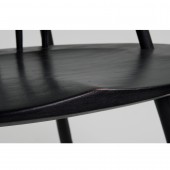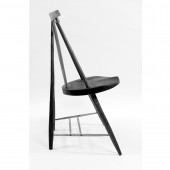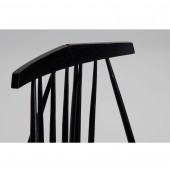
| THE AWARD |
| CATEGORIES |
| REGISTRATION |
| SUBMIT YOUR WORK |
| ENTRY INSTRUCTIONS |
| TERMS & CONDITIONS |
| PUBLICATIONS |
| DATES & FEES |
| METHODOLOGY |
| CONTACT |
| WINNERS |
| PRESS ROOM |
| GET INVOLVED |
| DESIGN PRIZE |
| DESIGN STORE |
| THE AWARD | JURY | CATEGORIES | REGISTRATION | PRESS | WINNERS | PUBLICATIONS | ENTRY INSTRUCTIONS |
'a' Back Windsor Dining Chair by Stoel Burrowes |
Home > Winners > Design #24774 >Interview |
 |
|
FS: What is the main principle, idea and inspiration behind your design?
SB: Solid hardwood, traditional joinery and contemporary machinery update the fine Windsor Chair. The front legs pass through the seat to become the king post and the back legs reach to the crest.
FS: What has been your main focus in designing this work? Especially what did you want to achieve?
SB: Traditional Windsor, Fine Woodworking and Contemporary Design. With triangulation this design realigns the forces of compression and tension to maximum visual complexity with physical strength and comfort.
FS: What are your future plans for this award winning design?
SB: I am currently making arms and rockers for another iteration of this design. I anticipate selling individuals or sets of chairs. I will continue to make the chairs myself but anticipate selling or licensing the design to be manufacured on a larger scale.
FS: How long did it take you to design this particular concept?
SB: 25 years of experience and research in woodcraft and furniture design and production have led to the design/build of this chair. Original iterations, models, prototypes and production in North Carolina, USA. Teaching design at The University of North Carolina at Greensboro has also been important to this development of the ‘A’ Back Windsor Chair.
FS: Why did you design this particular concept? Was this design commissioned or did you decide to pursuit an inspiration?
SB: May 2010, an initial prototype after numerous models, sketches and parts samples is produced. July 2011 an initial order is delivered.
FS: Is your design being produced or used by another company, or do you plan to sell or lease the production rights or do you intent to produce your work yourself?
SB: While, now, producing this chair myself, I am open to the possibility of selling or leasing the production rights.
FS: What made you design this particular type of work?
SB: Extensive experience with hardwood furniture building and design informs an intimate material and process understanding. The designer studies and teaches Windsor, Shaker, Scandinavian and Contemporary design and manufacture.
FS: Where there any other designs and/or designers that helped the influence the design of your work?
SB: The technology, craft and minimalist presence of Windsor and Shaker chairs have influence me most directly. George Nakashima's work has inspired me through its honesty to materials and precision of proportions. I have learned from the work of many craftsmen and their anonymity speaks to me strongly of the importance of the work, the heritage, the tradition over the name.
FS: Who is the target customer for his design?
SB: Light and strong, this solid wood chair has an upright feel suitable for dining, task or occasional seating. The ambiguous play of form and structure in a traditional chair language makes this chair a modern design statement with strong utility and human factors.
FS: What sets this design apart from other similar or resembling concepts?
SB: The Crest is steam bent Ash. The Spindles (Ash) and Legs (White Oak) are a combination of lathe turning and spoke shaved with special attention to straight grain for strength. The Seat is Poplar and cut using CNC technology with hand sanding. All joints are well fit and glued with wedges where the Back Spindles pass through the Seat. Fine sanding and Milk Paint or Oil Finish with Wax complete this redesign of a traditional Windsor Chair.
FS: How did you come up with the name for this design? What does it mean?
SB: Windsor chairs are often named by their ‘back’ style (‘Fan Back’, ‘Continuous Arm’, ‘Bird Cage’). Thus, this chair is named for the form created by the legs and spindles, especially as seen from the back.
FS: Which design tools did you use when you were working on this project?
SB: Most of the design work was done with a combination of Hand tools, electric tools and drawing with a pencil. A dozen specific full scale prototypical joints and mock-ups along with at least a hundred sketches of details and iterations lead to a final prototype. From this prototype computer images were were generated to program a CNC to assist in the seat carving and to specify leg and spindle turnings.
FS: What is the most unique aspect of your design?
SB: The Front Leg passes through a 1" compound angled hole/through mortice in the Seat. The Front Legs provide a 'ledge' on which the Seat rests. The sophistication of the compound angle boring in the seat and the crest and the precision of parts allows for this design.
FS: Who did you collaborate with for this design? Did you work with people with technical / specialized skills?
SB: Jonathon Anderson, Assistant professor, UNCG-IAR, is instrumental in making computer files and running the CNC. Terry Brown is an expert wood turner and has assisted greatly in the production and precision of parts.
FS: What is the role of technology in this particular design?
SB: The CNC carved seat is dished out in a traditional seat pan of the Windsor but in an oval form. A radial drill press maintains consistency and accuracy in the bored holes. Careful, lathe turning with attention to long grain strength is finished traditionally with a spokeshave. Thus, a balance of cutting edge, 21st century, technology with traditional, even thousand year old, technology integrates a poetic statement in wood.
FS: Is your design influenced by data or analytical research in any way? What kind of research did you conduct for making this design?
SB: Research important to the development of the ‘A’ Back Windsor includes human factors studies: The Chair : Rethinking Culture, Body, and Design, by Cranz, Rethinking Sitting, by Opsvik, and Human Dimension & Interior Space : A Source Book of Design Reference Standards, by Panero and Zelnik. The Windsor Style in America, by Santore is influential.
FS: What are some of the challenges you faced during the design/realization of your concept?
SB: Designed as a Dining Chair, the ‘up-right’ ergonomics is nearly puritanical. However, the space created in and behind can justify the wide stance. The technology and economy of the Windsor Chairs and the Shaker Chairs inform this design most profoundly. A care and respect for craft and materials, along with the integration of seat to structure, reflect both historically and futuristically.
FS: How did you decide to submit your design to an international design competition?
SB: An online search of competition possibilities lead me to find and follow up on the 'A' Design Award and Competition
FS: What did you learn or how did you improve yourself during the designing of this work?
SB: Humility, respect for craft and materials, patience could, would and should improve.
FS: Thank you for providing us with this opportunity to interview you.
A' Design Award and Competitions grants rights to press members and bloggers to use parts of this interview. This interview is provided as it is; DesignPRWire and A' Design Award and Competitions cannot be held responsible for the answers given by participating designers.
| SOCIAL |
| + Add to Likes / Favorites | Send to My Email | Comment | View Press-Release | Translations |





